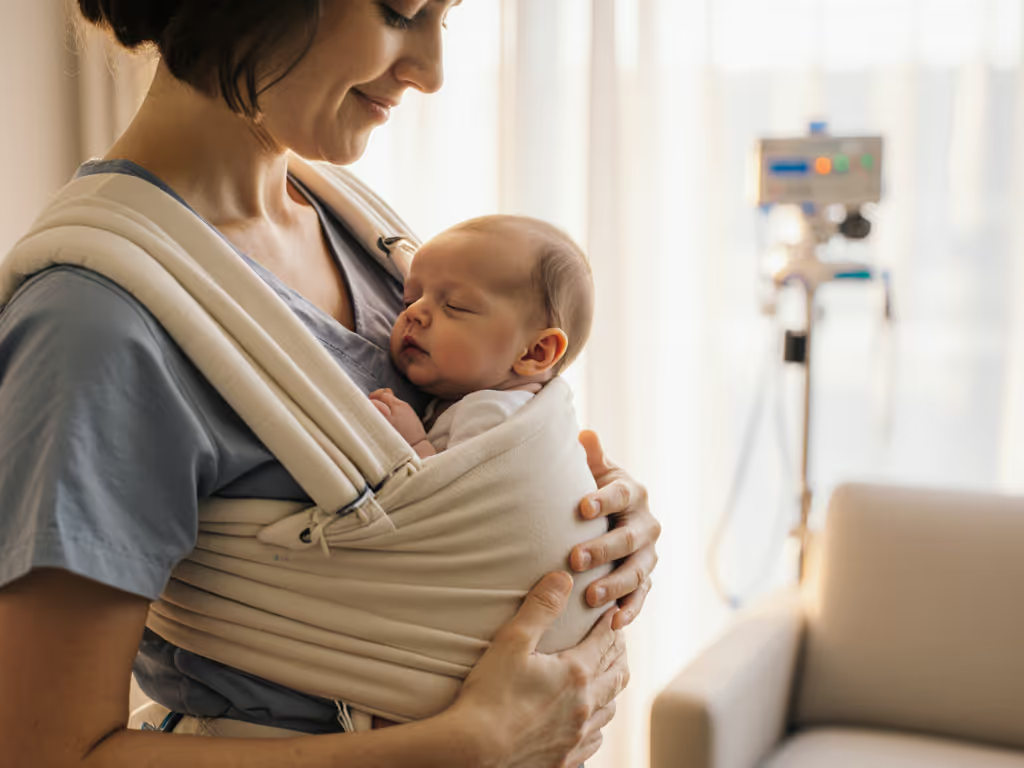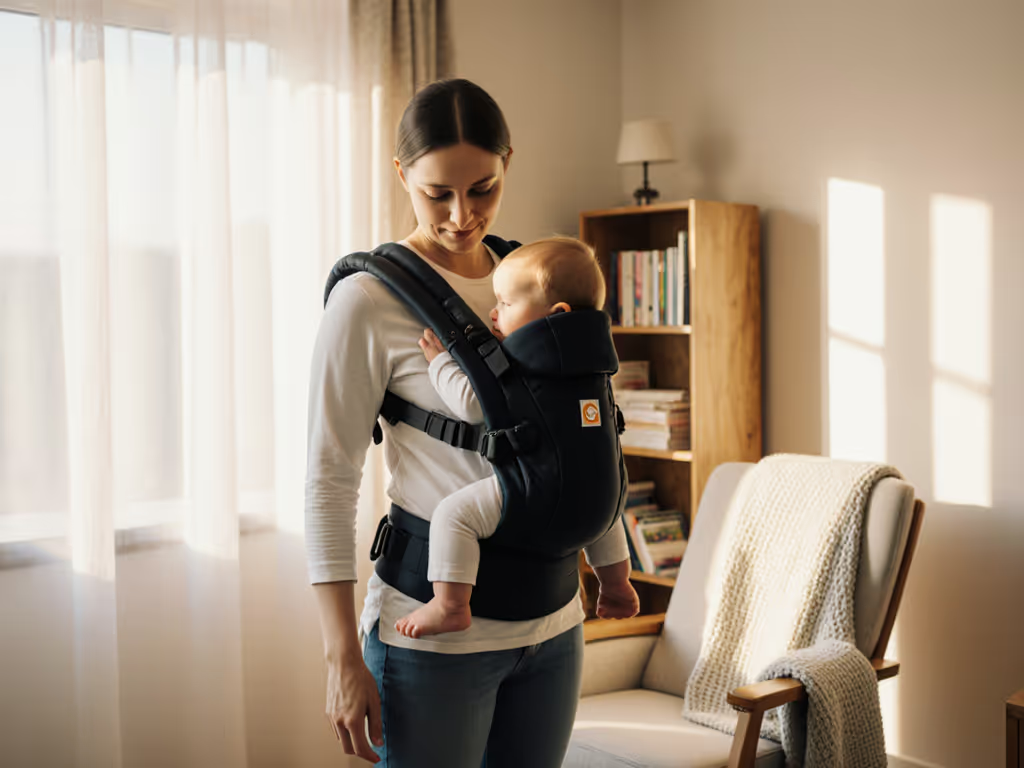
Complete Guide to Babywearing for Preemies

Nearly one in ten babies worldwide is born preterm, making early care a challenge faced by millions of families. These tiny newborns have unique needs that standard care does not always meet. Babywearing offers more than warmth and soothing touch. Backed by science, this close physical contact delivers critical benefits like improved temperature and heart rate stability for preterm infants. Learning how babywearing supports their fragile development helps parents create a safer, more connected start.
Key Takeaways
| Point | Details |
|---|---|
| Importance of Babywearing | Babywearing is crucial for preterm infants, providing physiological regulation, emotional bonding, and developmental support. |
| Benefits for Development | This technique promotes thermoregulation, stress reduction, and improved attachment, significantly enhancing preterm infant outcomes. |
| Carrier Selection | Choose wrap-style carriers with adjustable positioning and proper support to ensure safety and comfort for preterm infants. |
| Safety Guidelines | Adhere to ergonomic positioning and continuous monitoring to mitigate risks and ensure optimal development for preterm infants. |
Defining Babywearing for Preterm Infants
Babywearing represents a powerful nurturing technique where caregivers physically carry their infant using specialized cloth devices that enable consistent body contact. For preterm infants, this practice transcends simple transportation - it becomes a critical developmental intervention with profound physiological and emotional benefits.
Preterm infants require unique care approaches, and babywearing emerges as a scientifically supported method to support their delicate developmental needs. Research demonstrates that skin-to-skin contact through babywearing can help stabilize critical physiological parameters like heart rate, breathing patterns, and body temperature. These micro-interactions simulate the protective environment of the womb, providing neurological and emotional security during a vulnerable transition period.
The core principles of babywearing for preterm infants center on three fundamental aspects:
- Physiological Regulation: Helping infants maintain stable body systems
- Emotional Bonding: Creating secure attachment between caregiver and infant
- Developmental Support: Promoting neurological and sensory integration
Clinical studies highlight that consistent, gentle contact through babywearing can reduce stress hormones, improve weight gain trajectories, and enhance overall infant responsiveness. By creating a protective, consistent environment that mimics intrauterine conditions, caregivers can actively participate in their preterm infant's critical developmental journey.
Essential Benefits for Preemie Development
Babywearing represents a transformative intervention for preterm infants, offering a comprehensive approach to supporting critical developmental milestones through intimate physical contact. Unlike traditional care methods, this practice provides a holistic strategy that addresses multiple dimensions of infant growth and well-being.
Physiological stabilization emerges as a primary benefit, with research demonstrating significant improvements in several key areas. Preterm infants experience enhanced thermoregulation, meaning their body temperature remains more consistent during babywearing. Heart rate and respiratory patterns become more regulated, mimicking the protective environment they experienced in utero. This physiological synchronization helps reduce stress markers and supports overall nervous system development.
The emotional and neurological benefits of babywearing are equally profound:
- Stress Reduction: Decreases cortisol levels in both infant and caregiver
- Neurological Stimulation: Promotes sensory integration and cognitive development
- Attachment Enhancement: Strengthens parent-infant bonding through consistent physical proximity
Beyond immediate physiological advantages, babywearing contributes to long-term developmental outcomes. Studies indicate that preterm infants who experience consistent, gentle physical contact demonstrate improved weight gain, enhanced neurological responsiveness, and more robust immune system development. By creating a nurturing, responsive environment, caregivers can actively participate in their preterm infant's critical developmental trajectory, transforming medical challenges into opportunities for growth and connection.

Carrier Types Suitable for Preemies
Choosing the right carrier for a preterm infant requires careful consideration of specialized design features that support their unique physiological needs. Not all baby carriers are created equal, especially when it comes to the delicate requirements of premature babies who demand exceptional support, positioning, and safety.
Wrap-style carriers emerge as the gold standard for preterm infant care, offering unparalleled flexibility and customized support. These soft, stretchy fabric carriers create a womb-like environment that mimics the gentle containment preemies experienced before birth. The key advantage lies in their ability to distribute weight evenly, maintain a physiologically neutral position, and provide consistent skin-to-skin contact that is critical for neurological and emotional development.
When selecting a carrier for a preemie, prioritize these essential characteristics:
- Adjustable Positioning: Allows precise customization for infant's size and medical needs
- Breathable Fabrics: Prevents overheating and supports temperature regulation
- Structured Head and Neck Support: Critical for premature infants with limited muscle control
- Lightweight Design: Minimizes stress on both caregiver and infant
Beyond physical design, the ideal preemie carrier must accommodate potential medical equipment and support the infant's fragile physiological systems. Consultation with healthcare professionals can help identify the most appropriate carrier type, ensuring that babywearing becomes a safe, nurturing experience that supports the preterm infant's complex developmental journey.
Here's a summary of key carrier features to consider for preterm infants:
| Feature | Importance for Preemies | Example Benefit |
|---|---|---|
| Adjustable Positioning | Custom fit for size & needs | Safe, comfortable support |
| Breathable Fabrics | Prevents overheating | Stable temperature |
| Head/Neck Support | Supports underdeveloped muscles | Reduces airway risk |
| Lightweight Design | Minimizes caregiver strain | Extended wearing possible |
| Medical Equipment Room | Fits tubes & monitors | Continues clinical care |
|
Safe Positioning and Support Guidelines
Positioning a preterm infant in a carrier requires meticulous attention to detail, transforming babywearing from a simple transportation method into a carefully orchestrated developmental support strategy. The fragile nature of premature infants demands an approach that prioritizes their unique physiological vulnerabilities and developmental needs.
Ergonomic positioning stands as the cornerstone of safe babywearing for preemies. The infant must be held in a flexed, physiologically natural position that mimics their intrauterine environment. This means maintaining a slight curve in the spine, with legs spread in a natural "M" configuration and hips fully supported. The carrier should provide comprehensive support that prevents slumping, ensures an open airway, and maintains a consistent body temperature.
Critical safety guidelines for preemie babywearing include:
- Airway Protection: Keep infant's face visible and chin off chest
- Spine Alignment: Maintain natural curved posture
- Head Support: Provide consistent neck and head stabilization
- Temperature Regulation: Use breathable materials that prevent overheating
- Constant Monitoring: Regularly check infant's position and comfort
Beyond physical positioning, successful babywearing requires ongoing caregiver vigilance. Preterm infants cannot communicate discomfort as readily as full-term babies, making continuous observation crucial. Healthcare professionals recommend frequent position checks, ensuring the infant remains in an optimal physiological state that supports their delicate developmental journey. By combining scientific precision with nurturing care, caregivers can transform babywearing into a powerful developmental intervention.
Risks, Precautions, and Contraindications
Babywearing with preterm infants demands an extraordinarily nuanced approach, where understanding potential risks becomes as crucial as recognizing the intervention's profound benefits. The delicate physiological status of premature infants requires caregivers to navigate a complex landscape of safety considerations with exceptional vigilance and informed decision-making.
Medical contraindications represent the primary area of concern for preterm infant babywearing. Certain clinical conditions may temporarily or permanently limit the appropriateness of carrier use. These include respiratory complications, unresolved cardiac issues, unstable neurological conditions, and specific orthopedic challenges that compromise the infant's ability to maintain a safe, supported position. Healthcare professionals strongly recommend comprehensive medical consultation before initiating any babywearing practice.
Key risk mitigation strategies include:
- Continuous Monitoring: Observe infant's breathing and color constantly
- Weight Considerations: Ensure infant meets minimum safe weight requirements
- Medical Equipment Compatibility: Accommodate oxygen lines, feeding tubes, or monitoring devices
- Temperature Management: Prevent overheating or excessive cooling
- Positioning Precision: Maintain optimal spine and hip alignment
Beyond immediate medical concerns, caregivers must remain alert to subtle signs of infant distress. Preterm infants cannot articulate discomfort as readily as full-term babies, making vigilant observation paramount. Periodic assessments with healthcare providers, combined with a cautious, informed approach to babywearing, can transform this practice from a potential risk into a powerful developmental support mechanism.
Support Your Preemie’s Development with Safe Babywearing Solutions
Caring for a preterm infant is filled with unique challenges, especially when it comes to providing the gentle, consistent contact they need for healthy development. This article highlights how babywearing supports physiological regulation, emotional bonding, and neurological growth for preemies, while emphasizing the importance of proper positioning and choosing the right carrier. If you are seeking to navigate the complexities of safely carrying your preterm infant and want guidance on how to select the perfect carrier designed to meet their delicate needs, expert resources are available to help.
At Caregiver Carry, we specialize in detailed, evidence-based babywearing education tailored to sensitive situations like preemie care. Discover step-by-step positioning guides that prioritize head and neck support, explore comprehensive reviews of soft, adjustable wrap carriers that offer breathable fabrics and medical equipment compatibility, and learn how to monitor your baby’s comfort every moment of the day. Take confident steps toward nurturing your preterm infant’s growth by visiting Caregiver Carry’s main site today and unlock trusted advice for every caregiver committed to safe and loving babywearing.
Frequently Asked Questions
What are the benefits of babywearing for preterm infants?
Babywearing for preterm infants provides several benefits, including physiological stabilization, emotional bonding, and developmental support. It helps maintain stable heart rates, breathing patterns, and body temperature while promoting attachment between the caregiver and infant.
How can I choose the right baby carrier for my preterm infant?
When selecting a baby carrier for a preterm infant, prioritize features such as adjustable positioning, breathable fabrics, structured head and neck support, and a lightweight design to ensure safety, comfort, and functionality.
What are the essential guidelines for positioning a preterm infant in a carrier?
Positioning guidelines include ensuring the infant maintains a flexed, natural posture, keeping the airway unobstructed, providing consistent head and neck support, and monitoring the infant's position regularly to ensure safety and comfort.
What precautions should I take when babywearing a preterm infant?
Precautions include continuous monitoring of the infant’s breathing and color, ensuring proper weight considerations, accommodating any medical equipment, managing temperature effectively, and maintaining precise positioning to avoid any risks.



